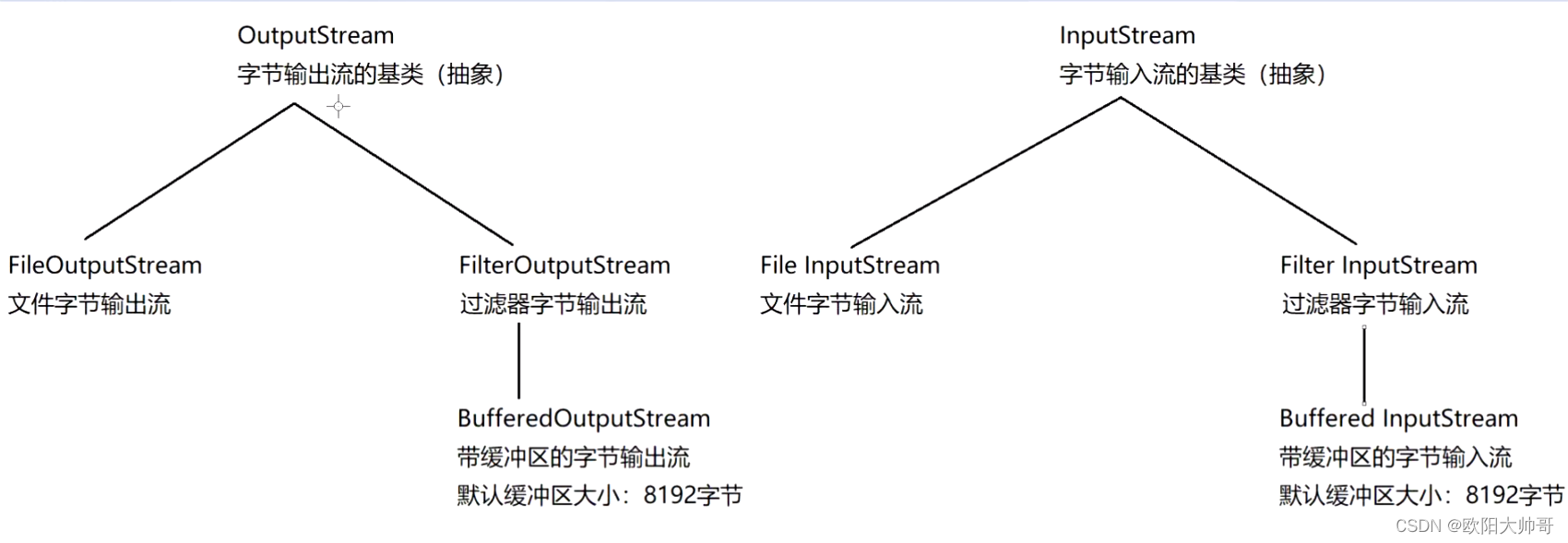字节流
- 字节流:
- 操作:
- 文件字节输入输出流 :
- 写入数据:
- 读取数据:
- 文件拷贝:
- 带缓冲区的字节输入输出流:
- 拷贝文件:
- 写入数据:
- 读取数据:
- 深入 带缓冲区的字节输出流 :
- 底层源码:
字节流:
应用场景:操作二进制数据(音频、视频、图片)
abstract class InputStream – 字节输入流的基类(抽象类)
abstract class OutputStream – 字节输出流的基类(抽象类)
class FileInputStream extends InputStream – 文件字节输入流
class FileOutputStream extends OutputStream – 文件字节输出流
class FilterInputStream extends InputStream – 过滤器字节输入流
class FilterOutputStream extends OutputStream – 过滤器字节输出流
class BufferedInputStream extends FilterInputStream – 带缓冲区的字节输入流
class BufferedOutputStream extends FilterOutputStream – 带缓冲区的字节输出流
默认缓冲区大小:8192字节----> new byte[8192]

操作:
文件字节输入输出流 :
写入数据:
利用 文件字节输出流 向文件 写入 数据。
1. 不处理异常 2. 当文件存在时
3. 当文件不存在时
经验:所有的输出流,当文件不存在时都会创建该文件。
public static void main(String[] args) throws IOException {//1.创建流对象FileOutputStream fos = new FileOutputStream("io.txt");//2.写入数据//fos.write(97);//写入UniCode码//fos.write("123abc".getBytes());//字符串转为byte数组,并写入文件中fos.write("123abc".getBytes(), 2, 3);//写入byte数组、偏移量、写入长度//3.关闭资源fos.close();}
利用 文件字节输出流 向文件 写入 数据。
1. 不处理异常 2. 当文件存在时
3. 当文件不存在时
4. 在文件末尾追加内容
经验:在文件末尾追加考虑基础流的构造方法。
public static void main(String[] args) throws IOException {//1.创建流对象 + 设置在文件末尾追加FileOutputStream fos = new FileOutputStream("io.txt",true);//2.写入数据fos.write("123abc".getBytes());//写入byte数组//3.关闭资源fos.close();}
利用 文件字节输出流 向文件 写入 数据。
1. 不处理异常 2. 当文件存在时
3. 当文件不存在时
4. 在文件末尾追加内容
5. 处理异常
public static void main(String[] args) {FileOutputStream fos = null;try {//1.创建流对象 + 设置在文件末尾追加fos = new FileOutputStream("io.txt",true);//2.写入数据fos.write("123abc".getBytes());//写入byte数组} catch (FileNotFoundException e) {e.printStackTrace();} catch (IOException e) {e.printStackTrace();} finally {//3.关闭资源if(fos != null){try {fos.close();} catch (IOException e) {e.printStackTrace();}}}}
读取数据:
利用 文件字节输入流 读取文件里的数据。
1. 不处理异常 2. 文件存在
public static void main(String[] args) throws IOException {//1.创建流对象FileInputStream fis = new FileInputStream("io.txt");//2.读取数据//read():一个字节一个字节的读取数据,读取到文件末尾返回-1int read = fis.read();System.out.println(read);read = fis.read();System.out.println(read);read = fis.read();System.out.println(read);read = fis.read();System.out.println(read);read = fis.read();System.out.println(read);read = fis.read();System.out.println(read);read = fis.read();System.out.println(read);//3.关闭资源fis.close();}
改进:
public static void main(String[] args) throws IOException {//1.创建流对象FileInputStream fis = new FileInputStream("io.txt");//2.读取数据//read():一个字节一个字节的读取数据,读取到文件末尾返回-1int read;while((read = fis.read()) != -1){System.out.println((char)read);}//3.关闭资源fis.close();}
再改进:
public static void main(String[] args) throws IOException{//1.创建流对象FileInputStream fis = new FileInputStream("io.txt");//2.读取数据//read(bs):读取bs长度的数据,并把数据放入数组,返回读取到的有效字节数,如果读取到文件末尾则返回-1byte[] bs = new byte[1024];int len;while((len = fis.read(bs)) != -1){System.out.println(new String(bs, 0, len));}//3.关闭资源fis.close();}
利用 文件字节输入流 读取文件里的数据。
1. 不处理异常
2. 文件存在
3. 文件不存在
4. 处理异常
public static void main(String[] args){FileInputStream fis = null;try {//1.创建流对象fis = new FileInputStream("io.txt");//2.读取数据//read(bs):读取bs长度的数据,并把数据放入数组,返回读取到的有效字节数,如果读取到文件末尾则返回-1byte[] bs = new byte[1024];int len;while((len = fis.read(bs)) != -1){System.out.println(new String(bs, 0, len));}} catch (FileNotFoundException e) {e.printStackTrace();} catch (IOException e) {e.printStackTrace();} finally {//3.关闭资源if(fis != null){try {fis.close();} catch (IOException e) {e.printStackTrace();}}}}
文件拷贝:
读取源文件,写入目标文件。
public static void main(String[] args) throws IOException {FileInputStream fis = new FileInputStream("Original.mp4");FileOutputStream fos = new FileOutputStream("copy.mp4");//一个一个字节的拷贝,速度太慢int read;while((read = fis.read()) != -1){fos.write(read);}fis.close();fos.close();}
改进:
public static void main(String[] args) throws IOException {FileInputStream fis = new FileInputStream("Original.mp4");FileOutputStream fos = new FileOutputStream("copy.mp4");//read(bs):读取bs长度的数据,并把数据放入数组,//返回读取到的有效字节数,如果读取到文件末尾则返回-1byte[] bs = new byte[1024];int len;while((len = fis.read(bs)) != -1){fos.write(bs, 0, len);}fis.close();fos.close();}
异常处理:
public static void main(String[] args){FileInputStream fis = null;FileOutputStream fos = null;try {fis = new FileInputStream("Original.mp4");fos = new FileOutputStream("copy.mp4");byte[] bs = new byte[1024];int len;while((len = fis.read(bs)) != -1){fos.write(bs, 0, len);}} catch (FileNotFoundException e) {e.printStackTrace();} catch (IOException e) {e.printStackTrace();} finally {if(fis != null){try {fis.close();} catch (IOException e) {e.printStackTrace();}}if(fos != null){try {fos.close();} catch (IOException e) {e.printStackTrace();}}}}
改进:
public static void main(String[] args){//注意:小括号里创建的流会在try...catch后自动关闭try(FileInputStream fis = new FileInputStream("Original.mp4");FileOutputStream fos = new FileOutputStream("copy.mp4");) {byte[] bs = new byte[1024];int len;while((len = fis.read(bs)) != -1){fos.write(bs, 0, len);}} catch (FileNotFoundException e) {e.printStackTrace();} catch (IOException e) {e.printStackTrace();}}
带缓冲区的字节输入输出流:
拷贝文件:
public static void main(String[] args) throws IOException {BufferedInputStream bis = new BufferedInputStream(new FileInputStream("Original.mp4"));BufferedOutputStream bos = new BufferedOutputStream(new FileOutputStream("copy.mp4"));byte[] bs = new byte[1024];int len;while((len = bis.read(bs)) != -1){bos.write(bs, 0, len);}bis.close();bos.close();}
写入数据:
利用 带缓冲区的字节输出流 向文件写入数据
1. 不处理异常的方式 2. 文件存在的情况
3. 文件不存在的情况
经验:所有的输出流,文件不存在的情况都会创建文件。
public static void main(String[] args) throws IOException {//1.创建流对象BufferedOutputStream bos = new BufferedOutputStream(new FileOutputStream("io.txt"));//2.写入数据bos.write("123abc".getBytes());//3.关闭资源bos.close();}
利用 带缓冲区的字节输出流 向文件写入数据
不处理异常的方式
文件存在的情况
文件不存在的情况
在文件末尾追加内容
经验:在文件末尾追加考虑基础流的构造方法。
public static void main(String[] args) throws IOException {//1.创建流对象BufferedOutputStream bos = new BufferedOutputStream(new FileOutputStream("io.txt",true));//2.写入数据bos.write("123abc".getBytes());//3.关闭资源bos.close();}
利用 带缓冲区的字节输出流 向文件写入数据
不处理异常的方式
文件存在的情况
文件不存在的情况
在文件末尾追加内容
处理异常
public static void main(String[] args){BufferedOutputStream bos = null;try {//1.创建流对象bos = new BufferedOutputStream(new FileOutputStream("io.txt",true));//2.写入数据bos.write("123abc".getBytes());} catch (FileNotFoundException e) {e.printStackTrace();} catch (IOException e) {e.printStackTrace();} finally {//3.关闭资源if(bos != null){try {bos.close();} catch (IOException e) {e.printStackTrace();}}}}
读取数据:
利用 带有缓冲区的字节输入流 读取文件里的数据。
不处理异常
文件存在
文件不存在
经验:所有输入流,当文件不存在都会报错
public static void main(String[] args) throws IOException {//1.创建流对象 (默认缓冲区大小:8192字节)//BufferedInputStream bis = new BufferedInputStream(new FileInputStream("io.txt"));//1.创建流对象 (自定义缓冲区大小:2048字节)BufferedInputStream bis = new BufferedInputStream(new FileInputStream("io.txt"),2048);//2.读取数据 byte[] bs = new byte[1024];int len;while((len = bis.read(bs)) != -1){System.out.println(new String(bs, 0, len));}//3.关闭资源bis.close();}
利用 带有缓冲区的字节输入流 读取文件里的数据。
- 不处理异常
- 文件存在
- 文件不存在
- 异常处理
public static void main(String[] args) {BufferedInputStream bis = null;try {//1.创建流对象 (默认缓冲区大小:8192字节)bis = new BufferedInputStream(new FileInputStream("io.txt"));//2.读取数据 byte[] bs = new byte[1024];int len;while((len = bis.read(bs)) != -1){System.out.println(new String(bs, 0, len));}} catch (FileNotFoundException e) {e.printStackTrace();} catch (IOException e) {e.printStackTrace();} finally {//3.关闭资源if(bis != null){try {bis.close();} catch (IOException e) {e.printStackTrace();}}}}
深入 带缓冲区的字节输出流 :
public static void main(String[] args) throws IOException{// FileOutputStream fos = new FileOutputStream("io.txt");
// //写几次,就和硬盘交互几次 -- 6次(内存与硬盘交互的次数)
// fos.write("1".getBytes());
// fos.write("2".getBytes());
// fos.write("3".getBytes());
// fos.write("a".getBytes());
// fos.write("b".getBytes());
// fos.write("c".getBytes());
// fos.close();// BufferedOutputStream bos = new BufferedOutputStream(new FileOutputStream("io.txt"));
// //将数据写入到字节缓冲数组中 -- 1次(内存与硬盘交互的次数)
// bos.write("1".getBytes());
// bos.write("2".getBytes());
// bos.write("3".getBytes());
// bos.write("a".getBytes());
// bos.write("b".getBytes());
// bos.write("c".getBytes());
// //关闭时才将数据写入到文件中
// bos.close();//默认缓冲区 -- 8192个字节(8*1024)//BufferedOutputStream bos = new BufferedOutputStream(new FileOutputStream("io.txt"));//自定义缓冲区大小 -- 2048个字节
// BufferedOutputStream bos = new BufferedOutputStream(new FileOutputStream("io.txt"), 2048);}
底层源码:
//继承关系
public class FilterOutputStream extends OutputStream {protected OutputStream out;//0x001//out - 0x001public FilterOutputStream(OutputStream out) {this.out = out;}//b - [65]public void write(byte[] b) throws IOException {this.write(b, 0, b.length);}@SuppressWarnings("try")public void close() throws IOException {try (OutputStream ostream = out) {flush();}}
}
//源码
public class BufferedOutputStream extends FilterOutputStream {//缓冲区数组protected byte[] buf;//new byte[8192]//缓冲区存放数据的个数protected int count;//1//out - 0x001public BufferedOutputStream(OutputStream out) {this(out, 8192);}//out - 0x001//size - 8192public BufferedOutputStream(OutputStream out, int size) {super(out);if (size <= 0) {throw new IllegalArgumentException("Buffer size <= 0");}buf = new byte[size];}//b - [65]//off - 0//len - 1public synchronized void write(byte b[], int off, int len) throws IOException {//判断现在需要写出的数据长度是否大于缓冲区数组if (len >= buf.length) {//1 >= 8192//将缓冲区数组里的数据写入到文件,将缓冲区清空flushBuffer();//将线程需要写出的数据写入到文件out.write(b, off, len);return;}//判断现在需要写出的数据长度 超过了缓冲区剩余的存储长度if (len > buf.length - count) {//1 > 8192-0//将缓冲区数组里的数据写入到文件,将缓冲区清空flushBuffer();}//将数据写入到缓冲区数组里System.arraycopy(b, off, buf, count, len);//更新缓冲区数组数据个数count += len;}private void flushBuffer() throws IOException {//count > 0说明缓冲区数组里有数据if (count > 0) {super.out.write(buf, 0, count);//调用的是FileOutputSteam的write()count = 0;//缓冲区清空}}public synchronized void flush() throws IOException {//将缓冲区数组里的数据写入到文件,将缓冲区清空flushBuffer();super.out.flush();//调用的是FileOutputSteam的close() -- 关流}
}
//应用场景
FileOutputStream fos = new FileOutputStream("io.txt");//0x001
BufferedOutputStream bos = new BufferedOutputStream(fos);bos.write("1".getBytes());
bos.write("2".getBytes());
bos.write("3".getBytes());
bos.write("a".getBytes());
bos.write("b".getBytes());
bos.write("c".getBytes());bos.close();

)

![[WWW2024]轻量数据依赖的异常检测重训练方法LARA](http://pic.xiahunao.cn/[WWW2024]轻量数据依赖的异常检测重训练方法LARA)






)
)







)